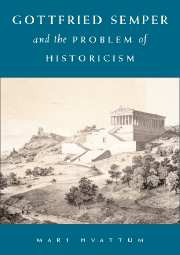Introduction – Gottfried Semper: Texts and Interpretations
Published online by Cambridge University Press: 06 August 2009
Summary
This study concerns a dilemma that for a long time has both disturbed and conditioned modern discourse on architecture. It is a dilemma played out in the tension between continuity and innovation: the desire to maintain tradition while at the same time find genuine expressions for contemporary culture. A body of work displaying this tension with particular incisiveness is that of the German architect and theorist Gottfried Semper (1803–79) (Figure 4). Semper struggled his whole life to formulate a “fundamental principle of invention, that with a logical certainty could lead to true form”. Yet, at the same time, he emphasised the need for historical continuity as an ontological basis for society and a creative source for architecture. The conflict between upholding tradition and simultaneously wishing to invent it by will is painfully present in his work, as it is in the history of modern architecture. It is this “fine ambiguity of Semper's system” that makes it so relevant for our present-day situation.
The ambiguity of Semper's position is mirrored in the multifarious ways his work has been interpreted. He has been labelled a materialist as well as an idealist, seen as a proto-functionalist who anticipated the Sachlichkeit of the modern movement, or as an eclecticist, legitimising nineteenth-century stylistic licentiousness. Some have seen him as a Marxist revolutionary: a heroic rebel whose aim it was to “displace the institutional location of architecture”; whereas others have dismissed him as a petit bourgeois and a defender of liberal capitalism.
- Type
- Chapter
- Information
- Gottfried Semper and the Problem of Historicism , pp. 7 - 26Publisher: Cambridge University PressPrint publication year: 2004

